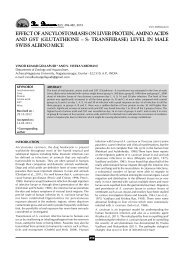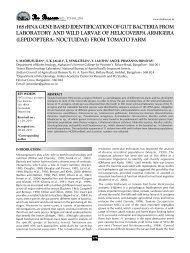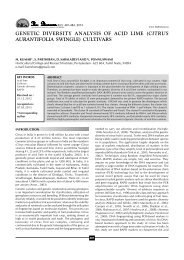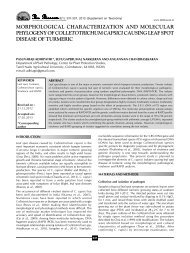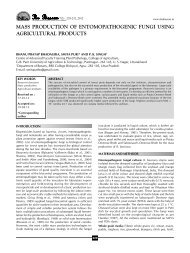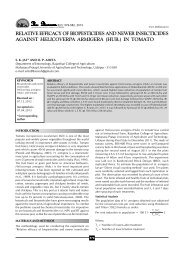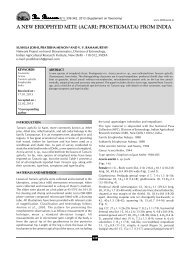SANTOSH KUMAR NAGALAPUR.pmd - THE BIOSCAN
SANTOSH KUMAR NAGALAPUR.pmd - THE BIOSCAN
SANTOSH KUMAR NAGALAPUR.pmd - THE BIOSCAN
- TAGS
- santosh
- kumar
- bioscan
- thebioscan.in
You also want an ePaper? Increase the reach of your titles
YUMPU automatically turns print PDFs into web optimized ePapers that Google loves.
<strong>SANTOSH</strong> <strong>KUMAR</strong> <strong>NAGALAPUR</strong> AND S. PARAMJYOTI<br />
gallic acid as the standard phenolic compound.<br />
1 mL of extract solution containing 1g extract in the volumetric<br />
flask was diluted with 46 ml of distilled water. 1mL of Folin-<br />
Ciocalteau reagent was added and the content of flask was<br />
mixed thoroughly. 3 minutes later 3 mL of 2% saturated sodium<br />
carbonate was added to the mixture and was allowed to stand<br />
for 2 hr with intermittent shaking. The absorbance of the blue<br />
color developed was read at 760 nm. The concentration of<br />
the total phenols was expressed as mg/g of dry extract (Kim et<br />
al., 2003). The concentration of total phenolic compounds in<br />
the extract was determined as µg of gallic acid equivalent<br />
using an equation obtained from the standard gallic acid curve.<br />
Absorbance = 0.0008 × gallic acid (µg).<br />
Determination of total flavanoids<br />
1mg samples were added to 1mL of 80% ethanol. Aliquot of<br />
0.5mL was added to the test tubes containing 0.1 mL of 10%<br />
aluminum nitrate, 0.1 mL of 1 M potassium acetate, and 4.3<br />
mL of 80% ethanol. The absorbance of the supernatant was<br />
measured at 415 nm after 40 minutes of incubation at room<br />
temperature. Total flavonoid concentration was calculated<br />
using quercetin as standard (Nieva Moreno et al., 2000).<br />
Absorbance = 0.002180 × µg quercetin – 0.01089.<br />
Ferric reducing activity<br />
Different concentrations of extracts (20µg, 100µg and 200µg)<br />
were mixed with 2.5 mL of 200 mmol/L sodium phosphate<br />
buffer (pH 6.6) and 2.5 mL of 1% potassium ferricyanide. The<br />
mixture was incubated at 50ºC for 20 minutes then 2.5 mL of<br />
10% trichloroacetic acid (w/v) was added, the mixture was<br />
centrifuged at 1000 rpm for 8 minutes, the upper layer was<br />
mixed with 5 mL of deionised water and 1 mL of 0.1% of ferric<br />
chloride, and the absorbance was measured<br />
spectophotometrically at 700 nm. (Barros et al., 2007). Higher<br />
absorbance of the reaction mixture indicated greater reducing<br />
power.<br />
DPPH radical scavenging activity<br />
Different concentrations of leaf extracts and Butylated hydroxyl<br />
anisole (BHA) (20µg, 100µg and 200µg) were taken and the<br />
volume was adjusted to 100µL by adding methanol. 5 mL of<br />
0.1 mM methanolic solution of 1, 2-Diphenyl picryl hydrazine<br />
(DPPH) was added. The mixture was shaken vigorously and<br />
allowed to stand for 30 minutes in dark. 0.01 mM solution of<br />
DPPH in methanol was used as control, whereas BHA was<br />
used as a standard. The reduction of DPPH radical was<br />
determined by measuring the absorption at 517 nm (Barros et<br />
al., 2007). The radical scavenging activity (RSA) was calculated<br />
as a percentage of DPPH discoloration using the equation:<br />
(Absorbance of control - Absorbance of<br />
sample)<br />
% RSA= X 100.<br />
(Absorbance of control)<br />
IC value for the extract i.e. the concentration at which it<br />
50<br />
scavenges 50 % of DPPH radical was calculated.<br />
Hydroxyl radical scavenging activity<br />
Different concentrations of leaf extracts and BHA (20 µg, 100µg<br />
and 200µg) were taken and the volume was adjusted to 250µL<br />
with 0.1 M phosphate buffer (pH 7.4). 1 mL of iron - EDTA<br />
solution (0.13% ferrous ammonium sulfate and 0.26% EDTA),<br />
106<br />
0.5 mL of EDTA (0.018%), and 1 mL of dimethyl sulphoxide<br />
(0.85% v/v in 0.1 M phosphate buffer, pH 7.4) were added to<br />
these solutions. The reaction was initiated by adding 0.5 mL<br />
of 0.22% ascorbic acid. The reaction mixtures were incubated<br />
at room temperature for 30 minutes. The reaction was<br />
terminated by the addition of 1mL of ice-cold TCA (17.5% w/<br />
v). 3mL of Nash reagent was added and the reaction mixture<br />
was allowed to stand at room temperature for 15 minutes for<br />
colour development. The intensity of the yellow colour formed<br />
was measured spectrophotometrically at 412 nm against the<br />
reagent blank (Singh et al., 2002). The percentage of hydroxyl<br />
radical scavenging activity (HRSA) was calculated by using<br />
following equation:<br />
% HRSA=<br />
1- (Absorbance of sample)<br />
(Absorbance of Blank)<br />
X 100.<br />
IC value of the extract was calculated as mentioned earlier.<br />
50<br />
Statistics<br />
The experiments were done in triplicate. Data are expressed<br />
as mean ± SEM. One- way analysis of variance (ANOVA) was<br />
used and the Dunnet’s test was used for comparison of mean<br />
values. All tests were considered to be statistically significant<br />
at p



